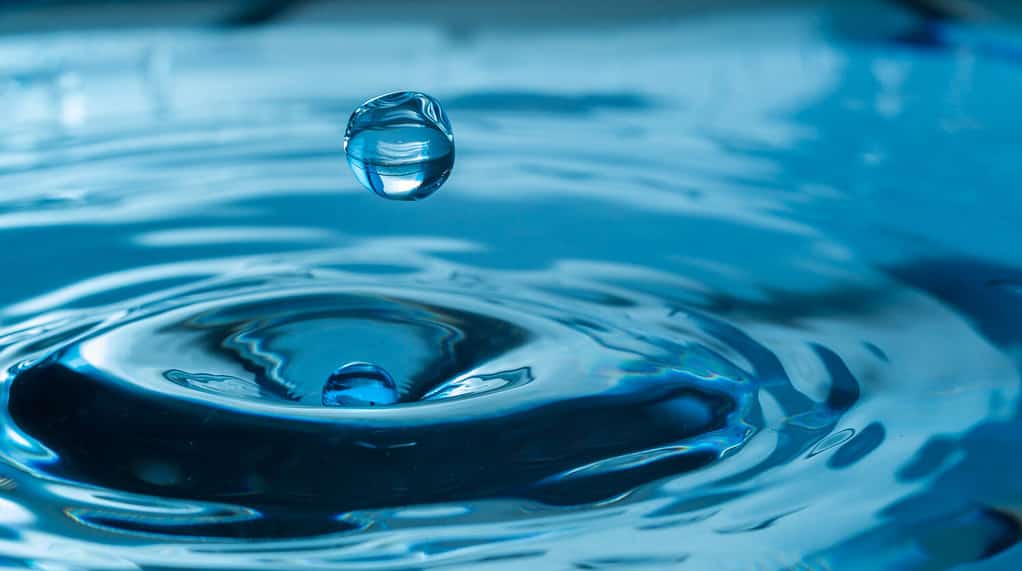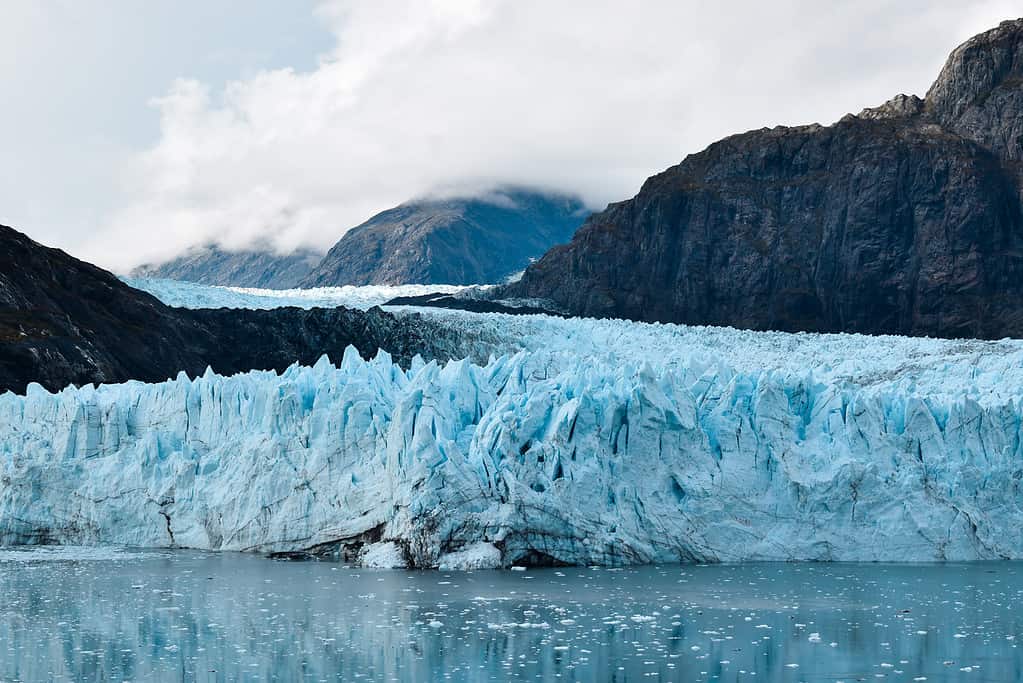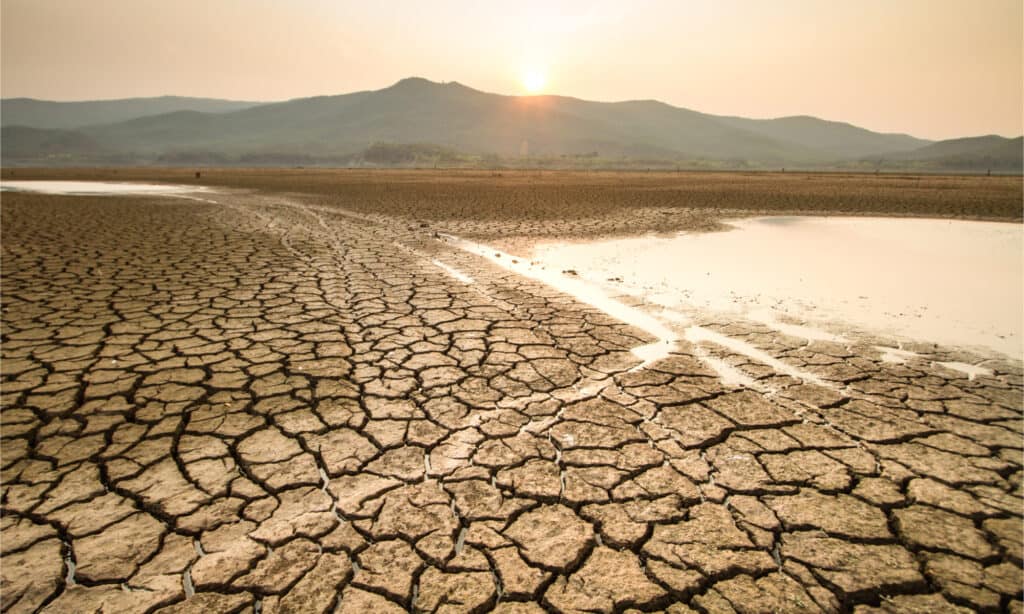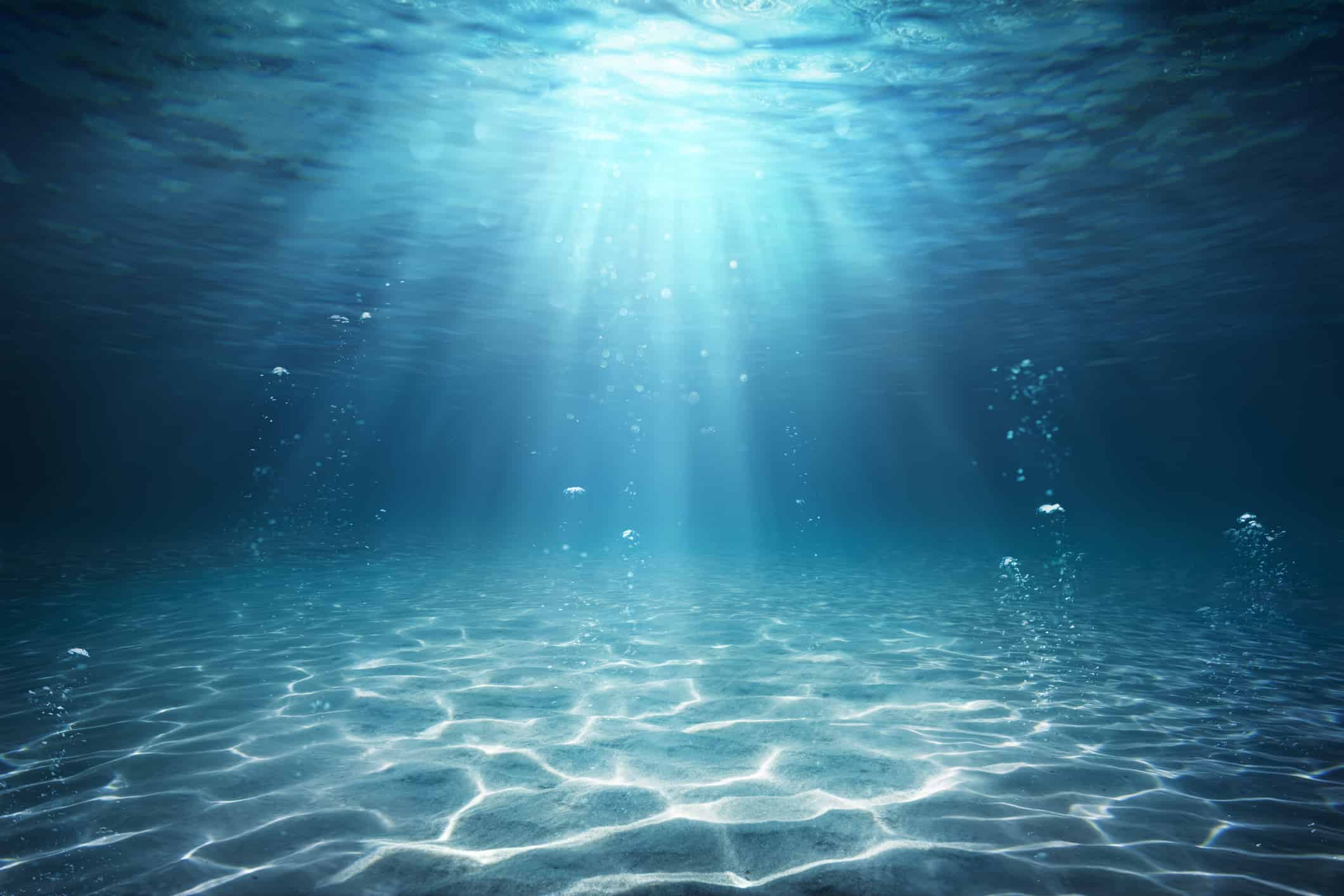Pure water, H2O, is one of the most important compounds on the planet. According to the U.S. Geological Survey, approximately 71 percent of the Earth’s surface is covered in water, and 96.5 percent of the water on Earth is contained in the oceans. Only a fraction of a percent of the planet’s water is drinkable, freshwater found on the surface of the Earth. Yet, we depend on a constant supply of water for our very survival. The human body contains at least 60 percent water, a number that varies depending on the individual’s condition. Plants average about 90 percent water, and they can reach up to 95 percent depending on the type. Life as we know it would not exist without water. So, let’s learn about the molar mass of water, its structure, and how it compares to other compounds in our world.

Water is, perhaps, the most important compound on the planet.
©Peter Bocklandt/Shutterstock.com
The Molar Mass of Water
Water, H2O, is a pure substance. A pure substance has the same chemical composition throughout, including even the smallest particles. A glass of water from your kitchen faucet or a bucket of water from the nearest river would contain pure H2O along with various other chemicals and larger particles, such as dirt, bacteria, and more. When referring to water, for the purposes of this discussion, we will limit the definition to the pure substance. Pure H2O contains only water molecules.
In chemistry, pure substances include all the elements on the periodic table, as well as all defined chemical compounds such as H2O. The smallest particles in a compound are molecules, and the smallest particles in elements are atoms. The molar mass of a pure substance influences the physical and chemical properties of the substance. The molar mass of water is 18.02 grams per mole.
What Is Molar Mass?
What exactly is the molar mass of a substance? The molar mass of a pure substance is defined as the mass of one mole of that substance expressed in grams. Okay, but what is a mole? A mole is simply a word to describe a particular number of items, specifically 6.022 × 1023 items. Think of it like a dozen. One dozen equals 12 items. One dozen doughnuts, for instance. One mole equals 6.022 × 1023 items, but we generally use moles to measure tiny things like atoms or molecules rather than doughnuts.
We call the giant number of items that makes up a mole Avogadro’s number. This constant, approximately 6.022 × 1023, was named for the Italian scientist, Amadeo Avogadro. It is always the same, and it is essential to understanding chemistry and how the world works.
Molar Mass vs. Atomic Mass
We can determine the molar mass of any element by looking at the periodic table to determine its atomic mass. This atomic mass, usually listed just below or to the side of the chemical symbol, should be noted on the table’s key. Scientists have carefully calculated the atomic mass of each element by taking into account all the known isotopes of the element. The average masses of these isotopes, weighted by their proportion as found in nature, determine the atomic mass of the element.
Every element on the periodic table has a fixed number of protons, each with a value of one atomic mass unit. The number of protons in an atom’s nucleus equals the atomic number of that element. Most elements have a variable number of neutrons, also with a value of one atomic mass unit each. We call atoms of a particular element with different numbers of neutrons isotopes. The number of neutrons in a particular atom determines which isotope of the element the atom represents.
To find the atomic mass of an atom, one must add all the protons and neutrons in its nucleus. Remember, each individual proton or neutron has a value of one atomic mass unit. The mass of any number of electrons in the atom’s orbitals is so tiny that it can be disregarded. Each isotope of an element will have a different atomic mass because even though they have the exact same number of protons, the number of neutrons varies.
An Example of How Isotopes Work
We must fully understand how isotopes work in order to learn about molar mass. We can do this by looking closely at an example. Let’s examine the element, carbon, which has only three different isotopes: carbon-12, carbon-13, and carbon-14.
The lightest carbon isotope, carbon-12, has six protons and six neutrons. Therefore, its atomic mass equals 12. Carbon-13 has six protons and seven neutrons, with an atomic mass of 13. And the heaviest isotope, carbon-14, has six protons and eight neutrons, with an atomic mass of 14. If we average these three numbers, we get 13. But the actual calculated atomic mass of carbon, equals 12.011 atomic mass units. Because carbon-12 isotopes far outnumber carbon-13 and carbon-14 in nature, the average must be weighted. Therefore, the atomic mass skews heavily toward 12.
Calculating the Molar Mass of Water
So far, we have only discussed the molar mass of elements. As you learned, the molar mass of an element simply equals its atomic mass expressed in terms of grams per mole. This same concept applies to compounds, except we have to do some extra math. Each molecule of a compound contains two or more atoms of the same or different elements. To find the atomic mass of a compound, we simply add up the atomic masses of all the atoms in the molecule. The total equals the compound’s atomic mass.
Water, H2O, has three atoms in each molecule. It has one oxygen atom bonded to two hydrogen atoms. Therefore, one mole of water molecules has one mole of oxygen atoms and two moles of hydrogen atoms. To find the mass of one mole of oxygen, just convert the atomic mass of oxygen to grams. One mole of oxygen has a mass of 16.00 grams. And one mole of hydrogen has a mass of 1.008 grams. Adding the mass of the three atoms in this compound gives a total of 18.02 grams as the molar mass of water.
| Calculating Molar Mass of Water |
|---|
| Simplified chemical equation for water: H2 + ½O2 → H2O |
| 2 moles of hydrogen + 1 mole of oxygen → one mole of water |
| 2(1.008 grams H/mole) + 16.00 grams O/mole → 18.02 grams H2O/mole |
Atomic Structure of Water
Water is a molecular compound made up of just two elements: hydrogen and oxygen. When hydrogen and oxygen combine in a 2:1 ratio, we call the resulting compound, H2O, water.
Oxygen belongs to Group 16 on the periodic table. The members of Group 16 reside just two places away from Group 18, the noble gases. Atoms from this group need just two electrons to reach their desired, stable electron configuration. They usually form ions with a -2 charge, including the negatively charged oxygen ion, O2-.
Hydrogen atoms in nature usually bond to other hydrogen atoms to form a diatomic molecule. Single hydrogen atoms form ions with a +1 charge. These hydrogen ions easily form bonds with any negatively charged ion to form molecules with a neutral charge. When two H+ ions bond with one O2- ion, a water molecule forms with a neutral charge.
Water Configuration
The atoms in water arrange themselves in a bent structure with an approximate 104.5-degree bond angle. They form a bond known as a polar covalent bond. Covalent bonds share electrons so that both atoms can have a stable configuration with filled outer orbitals at least part of the time. A polar covalent bond is one in which an electron is unequally shared. One atom in the bonded pair gets the extra electron more of the time, giving it a partial negative charge, while the other atom has a partial positive charge.
In this case, oxygen has a greater attraction for the electrons than either of the hydrogen atoms, but not enough to completely take the electrons away. So, the bent molecule ends up polarized; it is more negative toward the oxygen atom, and more positive toward the ends where the hydrogen atoms lie.
Water in the Lab

The water used in a laboratory must be exceptionally pure.
©iStock.com/megaflopp
Water is perhaps the single most important compound used in laboratories. We call water the universal solvent because we can use it to dissolve more substances than any other compound. But laboratory water must be as pure as possible, to avoid unwanted chemical reactions and ensure that any experiments can be repeated reliably.
The pure H2O required for cleaning glassware and making solutions in a lab usually comes from distillation. Distilled water has been boiled to a vapor, then cooled and condensed back into a liquid in a separate, clean container. This process removes contaminants such as bacteria and other microbes, inorganic compounds such as minerals, and organic compounds. All that remains in distilled water, at least as far as possible, is pure H2O.
Water in Nature

Much of the Earth’s freshwater is held in glaciers and ice caps.
©Georgina Burrows/iStock/Getty Images via Getty Images
Water on Earth exists in solid, liquid, and gaseous phases. We can find water in the atmosphere as vapor. It exists in our oceans, lakes, and rivers as liquid saltwater and freshwater. In very cold climates, it exists as snow and ice, particularly in the massive expanses around the poles. We can even find water in reservoirs underground. Water is tied up in organic matter, both living and dead. A small but significant amount of water exists within the soil.
Roughly 97.5 percent of the Earth’s water is saline, with 96.5 percent of the total existing as saltwater in the planet’s oceans. Only about 2.5 percent of the water on Earth exists as freshwater, and a mere 1.2 percent of that total is not tied up as glaciers, ice caps, or groundwater. Of that small amount of available freshwater, about 4.5 percent runs through the world’s rivers, available for human consumption. That means just 0.00135 percent of the planet’s water even has the potential to come through our faucets.
Water as a Resource

Water supplies in many parts of the world are drying up faster than they can be replenished.
©Piyaset/Shutterstock.com
Looking at our planet, covered mostly in blue, it’s easy to think there is plenty of water to go around. But realizing just how little water is actually usable for drinking, bathing, irrigating crops, and everything else we do, the scarcity of usable freshwater can be frightening. Many parts of the planet, including much of the western United States, are struggling to allocate water to communities in desperate need. Perhaps we should not have built dense, metropolitan areas and huge agricultural operations in the middle of deserts.
Other Compounds
The following compounds share some similarities with water. Hydrogen peroxide is made of the same two types of atoms, hydrogen and oxygen, though in a different ratio. Ammonia and hydrogen sulfide are both compounds with polar molecules that can act as alternative solvents.
| Compound Name | Chemical Formula | Molar Mass | Interesting Uses |
| Water | H2O | 18.02 g/mol | Universal solvent; necessary for all life |
| Hydrogen peroxide | H2O2 | 34.01 g/mol | Antiseptic; bleaching agent |
| Ammonia | NH3 | 17.03 g/mol | Cleaning agent; fertilizer; manufacturing |
| Hydrogen Sulfide | H2S | 34.08 g/mol | Metallurgy; lubricants |
Conclusion
Our world would not be the same without water. Life, as we know it, would not exist without this important compound. Hopefully, you now have a better understanding of the molar mass of water, its chemical structure, where it is found in nature, and much more. Please do what you can to conserve this precious resource.
Thank you for reading! Have some feedback for us? Contact the AZ Animals editorial team.








